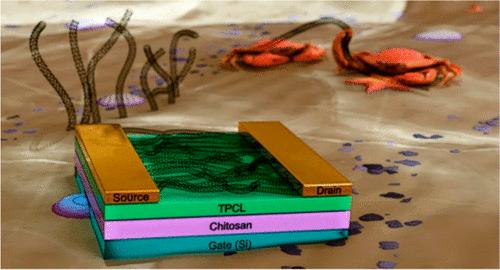壳聚糖电子器件:酸强度和塑化添加剂对器件性能的重要性
IF 5.4
2区 医学
Q2 MATERIALS SCIENCE, BIOMATERIALS
引用次数: 0
摘要
随着对智能包装、可穿戴电子设备和一次性使用源点传感器等一次性消费电子产品需求的增长,需要开发环保和可堆肥的电子材料。壳聚糖提取自甲壳类动物的废弃物,无需严格纯化即可提供高介电常数值,因此可用于大规模电子设备制造。在酸性介质中加工时,壳聚糖的质子化骨架与酸解离产生的反离子配对,形成具有电双层(EDL)和可调电容特性的壳聚糖薄膜。通过研究一系列具有不同 pKa 值的卤代酸和生物源酸以及不同 pH 值的溶液,我们报告了在加工壳聚糖时选择酸的重要性。草酸的性能优于其他酸,其最大面积电容为 161 nF-mm-2。酒石酸和柠檬酸尽管电容值较低,但也显示出良好的效果,具有稳定的 EDL 电容和较高的可重复性,是大面积生产的最佳选择。加入山梨醇作为增塑剂可将所有壳聚糖-酸组合的 EDL 形成起始频率提高到 1 × 103-105 Hz,并改善重现性。使用壳聚糖基电介质制作的高性能单壁碳纳米管薄膜晶体管经不同酸(含或不含山梨醇)处理后,电导率高达≈5.2 μS,离子/电离为 105。电容器和晶体管在环境条件下存放一年后仍能正常工作。总之,这项研究展示了基于壳聚糖的耐用高性能电子器件,并强调了加工酸和使用山梨醇等增塑添加剂的重要性。本文章由计算机程序翻译,如有差异,请以英文原文为准。

Chitosan-Based Electronics: The Importance of Acid Strength and Plasticizing Additives on Device Performance
A rise in demand for disposable consumer electronics such as smart packaging, wearable electronics, and single-use point-of-source sensors requires the development of eco-friendly and compostable electronic materials. Chitosan is derived from crustacean waste and offers high dielectric constant values without requiring rigorous purification, making it sustainable for large-scale electronic device manufacturing. When processed in acidic media, the protonated backbone of chitosan pairs with counterions from the acid dissociation to form chitosan thin films with electrical double layers (EDLs) and tunable capacitive properties. We report the importance of the choice of acid when processing chitosan by surveying a series of halogenated and biosourced acids with varying pKa values and solutions with different pH values. Oxalic acid outperforms other acids, with a maximum areal capacitance of 161 nF·mm–2. Tartaric acid and citric acid, despite lower capacitance values, showed promising results with a stable EDL capacitance and high reproducibility, making them optimal for large-area manufacturing. The incorporation of sorbitol as a plasticizer boosts the EDL formation onset of all chitosan–acid combinations to 1 × 103–105 Hz and improves reproducibility. High-performing single-walled carbon nanotube thin film transistors were made using chitosan-based dielectrics treated with different acids with and without sorbitol, leading to transconductance as high as ≈5.2 μS and Ion/Ioff of 105. The capacitors and transistors remain functional after one year of storage in ambient conditions. Overall, this study demonstrates durable high-performance electronics based on chitosan and stresses the importance of processing acid and the use of plasticizing additives, such as sorbitol.
求助全文
通过发布文献求助,成功后即可免费获取论文全文。
去求助
来源期刊

ACS Biomaterials Science & Engineering
Materials Science-Biomaterials
CiteScore
10.30
自引率
3.40%
发文量
413
期刊介绍:
ACS Biomaterials Science & Engineering is the leading journal in the field of biomaterials, serving as an international forum for publishing cutting-edge research and innovative ideas on a broad range of topics:
Applications and Health – implantable tissues and devices, prosthesis, health risks, toxicology
Bio-interactions and Bio-compatibility – material-biology interactions, chemical/morphological/structural communication, mechanobiology, signaling and biological responses, immuno-engineering, calcification, coatings, corrosion and degradation of biomaterials and devices, biophysical regulation of cell functions
Characterization, Synthesis, and Modification – new biomaterials, bioinspired and biomimetic approaches to biomaterials, exploiting structural hierarchy and architectural control, combinatorial strategies for biomaterials discovery, genetic biomaterials design, synthetic biology, new composite systems, bionics, polymer synthesis
Controlled Release and Delivery Systems – biomaterial-based drug and gene delivery, bio-responsive delivery of regulatory molecules, pharmaceutical engineering
Healthcare Advances – clinical translation, regulatory issues, patient safety, emerging trends
Imaging and Diagnostics – imaging agents and probes, theranostics, biosensors, monitoring
Manufacturing and Technology – 3D printing, inks, organ-on-a-chip, bioreactor/perfusion systems, microdevices, BioMEMS, optics and electronics interfaces with biomaterials, systems integration
Modeling and Informatics Tools – scaling methods to guide biomaterial design, predictive algorithms for structure-function, biomechanics, integrating bioinformatics with biomaterials discovery, metabolomics in the context of biomaterials
Tissue Engineering and Regenerative Medicine – basic and applied studies, cell therapies, scaffolds, vascularization, bioartificial organs, transplantation and functionality, cellular agriculture
 求助内容:
求助内容: 应助结果提醒方式:
应助结果提醒方式:


